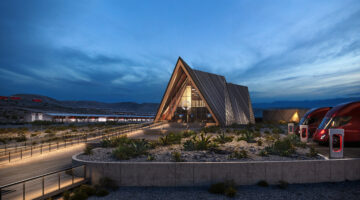Whether it be cruising down the highway or parked at the grocery store, electric vehicles are becoming a common sight in and around urban areas in the U.S. Based on consumer demand and government mandates related to emissions reduction, electric vehicles for everyday transportation are increasingly gaining market share from fossil fueled vehicles.
The most notable barrier to increasing market share is “range anxiety.” U.S. drivers are accustomed to finding frequent gas fueling stations along both urban streets and rural routes. However, with a typical range of 200 miles per charge , nearly all urban electric vehicle (EV) drivers would have adequate energy for their daily driving needs with nightly charging at home. In addition, the deployment of urban charging stations at offices, parking garages, business and filling stations will further alleviate range anxiety. For rural and interstate routes, additional charging stations will be required to enable long distance travel. As this demand becomes a reality, consumers should expect to see electric fueling stations with multiple high-voltage charging stations that can fully charge a vehicle in about 30 minutes.
To realize the benefits of convenient EV transportation, we will have to meet the new demand these charging stations will introduce to the power grid. For example, a fast charging electric fueling station serving twenty cars simultaneously would draw approximately 2 MW, or enough to power 1,000 homes.3 Sustaining this new demand in addition to traditional power needs like air conditioners, refrigerators and lighting will stress the existing and largely antiquated distribution network.
Encountering the EV challenge is just one example of why utilities are rapidly investing to modernize the distribution network with a focus on reliability. These current and planned investments well exceed those in the transmission market as preparations are underway for the convergence of increased need for distributed energy resources, smart infrastructure upgrades and electric vehicle charging.
Kiewit is serving the electric vehicle charging station infrastructure market through a unique partnership with LilyPad EV. This alliance melds Kiewit’s heritage of design and construction that dates back over 100 years and LilyPad EV’s hands-on experience deploying over 2,500 charging stations across the U.S. The duo will serve as a full solution provider offering planning, engineering, construction, procurement and installation of charging station ports for cities, electric utility companies, private fleets, and interstate corridors.
About the authors:
With more than 20 years of experience in the power industry, Jon Gribble leads Kiewit’s Power Delivery group. Jon provides guidance and insight to professionals focused on enhancing business operations and delivering the best value to clients across North America. Jon is responsible for market expansion and oversight of engineering in the power generation, power delivery, water and renewables markets.
Sam Scupham leads Emerging Markets within Kiewit’s Power Delivery group. His career in power and energy over the past 16 years includes extensive experience in conventional and renewable power generation, energy storage and electric vehicles. Sam is responsible for Kiewit’s market expansion in electric distribution engineering services.
Sources:
1 https://www.popularmechanics.com/cars/hybrid-electric/a19331/how-far-literally-can-the-electric-car-go/
2 https://www.powerelectronicsnews.com/technology/electric-vehicle-charging-stations-gain-speed-with-higher-voltages-and-currents
3 The ABCs of EVs: A Guide for Policy Makers and Consumer Advocates, Citizens Utility Board, p. 29.


